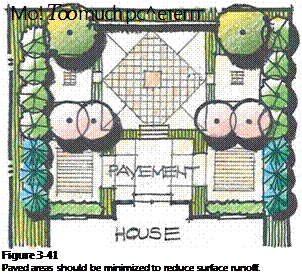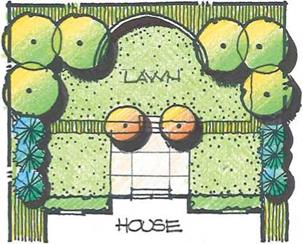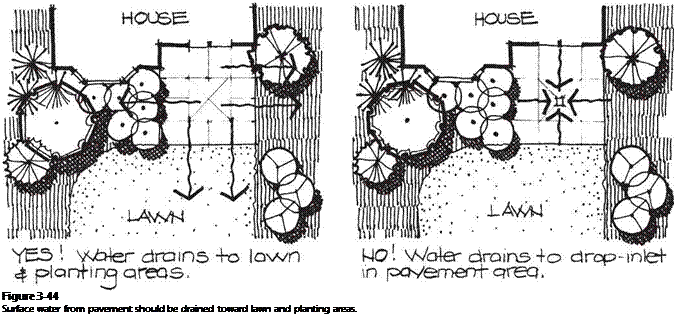Increased runoff from compacted soil and from hard, impervious surfaces is a significant environmental problem in urban and suburban areas. Many urban soils have the consistency of concrete and effectively create a solid barrier that prevents surface water from percolating into the ground. Further, roofs, streets, driveways, parking areas, patios, and walks seal the ground’s surface and prevent surface water from percolating into the soil. Not being able to enter the ground, the water runs off to nearby streams and rivers where it swells the volume of water flowing during and after a storm. This
increased water volume in turn causes downstream flooding, stream erosion, and an elevated amount of soil and pollutants carried in the water.
A sustainable landscape design should reduce surface runoff to a volume that equals or is less than what would occur if the site were completely natural. Many of the techniques for conserving water (see “Conserve Water” in this chapter) reduce surface runoff as well. Furthermore, improving the overall soil structure on a site can notably diminish runoff. As previously discussed, one very effective way to accomplish this is by adding compost to the soil before planting (see “Rehabilitate Soil” in “Site Restoration”).
Restricting the area of paved surfaces as much as possible can also moderate site runoff. Driveways, walks, patios, pool decks, and so on should be sized to minimum standards without sacrificing principles of good compositional design and needs for proper functioning. Paved areas that receive infrequent use or are inconsequential to the overall design should be reduced or eliminated (Figure 3—41).
|
YE5S1. pavepnerY minimized* |
 |
 |
Another approach to reducing surface runoff is to use porous pavement surfaces. Porous pavements have small gaps in the pavement material that permit surface water to seep through to the underlying ground, thereby reducing the quantity of runoff (Figure 3—42). Aggregate materials such as sand, gravel, crushed stone, wood chips, and so on are inherently porous surfaces. Brick, stone, concrete pavers, and wood laid with small spaces between the individual pieces of material on a sand or
 0ras/e!, Stone on sand base
0ras/e!, Stone on sand base
|
|
Vvb-ter percolates terctfcjh pavement,
gravel base are also porous pavements. In addition, some concrete paver manufacturers offer specially designed concrete pavers that intentionally create gaps between individual paving units, thus permitting surface water to infiltrate to the ground below (see Chapter 12, Figures 12—27 and 12—28, pages 403—404). Conventional pavements such as concrete and asphalt are impervious and should be minimized, although specially mixed porous concrete and asphalt surfaces are available. The latter, however, are only feasible in warm climates where surface water does not freeze.
One other example of porous pavement is grass pavement, which is composed of a concrete or plastic mesh with regularly spaced openings extending through it. The interconnected concrete or plastic framework provides the structural support while the gaps are filled with soil and planted with lawn or ground cover (Figure 3—43). This is an ideal pavement for walks and infrequently used driveway areas, not only for the environmental benefits but also because the structural framework tends to visually disappear, giving the surface a lawn-like appearance. Grass pavement is not practical where there is intense, frequent use or where snow removal is necessary.
Surface runoff from a residential site can also be reduced by draining it toward lawn and planting areas where it can more readily enter the ground (Figure 3—44).
![]()

Concrete or plastic structure Gross —
 |
 |
Similarly, the water from roofs can be drained into the soil by connecting downspouts to underground perforated pipes, allowing the water to seep directly into the ground (Figure 3—45). One increasingly popular idea is a “rain garden,” an artificially low area created to retain water that is drained toward it. Rain gardens should be placed downslope from where the surface water originates and integrated into the overall design of the site (Figure 3—46). A rain garden may be designed to look like a bog, a mini-wetland, a streamlike area with rocks, and so forth. Sandy or porous soil should be located underneath a rain garden to accommodate percolation of water into the soil, and the plants in a rain garden should be able to grow well in moist soil and to withstand periodic flooding (Figure 3—47). The surface water that is retained in a rain garden slowly percolates into the ground or is absorbed by the plants themselves.




